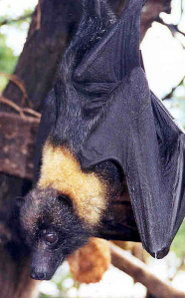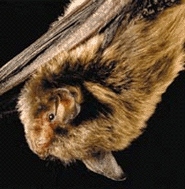Tuesday 24 March 2009
Mariana fruit bat

The
Mariana Fruit bat (
Pteropus mariannus) is an endangered species of bat only found habituating the Mariana Islands, including
Guam, and it is directly threatened by human behavior. Poaching has played a role in the decreasing numbers of the Mariana Fruit Bat, along with deforestation resulting in habitat loss and stress. Additionally this bat is found to be a popular local meal; however it is also linked to diseases and is a natural concentrator of pesticides much like other larger animals that accumulate DDT or similar chemicals from their food. Their diet consists of local fruit and nuts found in the trees, which they feast upon with their small but sharp teeth, they only eat plant matter and are of no threat to humans.
The Mariana fruit bat is a mid-sized bat, neither unusually large nor small for flying foxes (a flying fox is the nickname to megabats) and it can weigh up to a full pound (577 grams). Its forearm length ranges from 5 to 6 inches, (13-15.6cm); however the males are usually slightly larger. Their abdomens are usually a dark brown to black, while it has gray hairs throughout that appear to be scattered, their shoulders are usually a light brown or golden color, as are their necks while the head is particularly darker in tone. Individuals have much minor variation, with some having unusually light coloration, and others having much darker – but all within the ranges expected of this bat. They have very large eyes that make it easy for them to see, and rounded ears with a pointed muzzle, giving them the appearance of a canine. This is another reason they are called flying foxes.
The Binomial name of the Marianas Fruit bat is Pteropus mariannus mariannus. They belong to the genus Pteropus, which has some of the largest bat species in the world (P. vampyrus is the largest with a seven foot wingspan), and some of the most endangered species of bat in the world; it contains 64 known species (one was found as recently as a year ago – more are likely to be found). Pteropus belongs to the Subfamily Pteropodinae which contains 36 known Genera – many of which are endangered as entire Genera. Pteropodinae belongs to the Family Pteropodidae, of which there is only one other Subfamily with five Genera of bats. Pteropodidae belongs to the Suborder Megachiroptera of which they are the only member (however this is disputed – some suggest they belong to a new Suborder that also has a few microbat families based on recent genetic studies – if so it would be called Yinpterochiroptera). This in turn, belongs to the Order Chiroptera, which contains all of the bats. Chiroptera belongs to the Superorder Laurasiatheria, of which the
ungulates,
carnivores, and many other mammals are a member, and that in turn belongs to the Infraclass Eutheria – which is all the placental mammals.
Interesting Fact
The Mariana Fruit Bat, like other bats, might be a reservoir for diseases like Ebola, Marburg, and other hemorrhagic fevers, along with rabies and quite a few other diseases. They are naturally unaffected by the diseases, however
humans are not. Although only a fraction of a percent carries the diseases, there is always the possibility of infection as with any wild animal.
You can help spreading the word about this animal by liking it on facebook
Permanent Link
Friday 20 March 2009
Indiana bat

The
Indiana bat (
Myotis sodalis) is a brown to grayish bat which is listed as an endangered species due to population loss and habitat destruction. Its known range extends from the northern panhandle of Florida through Alabama and Georgia, north to cover all of Tennessee, parts of Western Virginia, and Northern Arkansas, along with all of Missouri, Indiana, Illinois, West Virginia, Ohio, southern Michigan, Pennsylvania, and upstate New York. It also has been found in some of the smaller states such as New Jersey, New Hampshire, and Vermont. The Indiana Bat is hard to distinguish from other related bats due to its similarities, especially a close relative of the Indiana Bat called the ‘little brown bat’. However the way they are told apart most often is the size of their feet, the length of the hairs on their toes, and also that instead of having black lips, theirs are pink. The Indiana Bat usually grows up to 2 inches and can weigh as much as a fourth of an ounce, additionally they live up to nine years in the wild, however some can live nearly double that amount of time – the record being 14 years. Its variations in color are often more brownish, however they can range from a lighter grayish color to a dark black.
They only eat insects that can also fly, and are a valuable asset to the environment in which man inhabits because they can consume thousands upon thousands of mosquitoes and other flying insects in just one night. The Indiana Bat is known to migrate, as throughout the summer it will spread far and wide – however in the winter it will
hibernate in very few caves. It is estimated that since the mid 70’s the population of the bat has been decimated, and is only at 50% of pre 1970’s levels today. The current estimated population is under but close to 250,000, and nearly 23% of that population hibernates in Indiana in just a few caves. When hibernating they will cluster into very tight groupings, and will live in caves that provide only the most optimal of conditions for their winter sleep.
Although it has a large range and overlaps with its close relative the Gray Bat, it has a significantly smaller population caused by destruction of colonies, pesticides, and the loss of habitat in the clearing of woodland for housing subdivisions and other habitat losses. The Indiana Bat is threatened by the WNS (white nose syndrome) a mysterious illness which has killed tens of thousands of bats. Although it may not be a direct cause, it is usually seen as a small white ring of fungus around the muzzle of an afflicted bat, and also on the wings. A recent disease, it was only first noted widely in 2006, and has so far been seen in thousands of bat deaths, and is spreading rapidly. Between 2006 and 2009 it spread to 9 states. Of the caves afflicted, mortality rates can be as high as 90%.
Their binomial name is Myotis sodalist, and they are in the genus Myotis – otherwise known as the Mouse Eared Bats. Myotis contains within it around 90 species of bat, and belongs to the Subfamily Myotinae. Myotinae has three genera and is a Subfamily of the Family Vespertilionidae, or vesper bats. Vespertilionidae is the largest Family of bats as far as species count goes, and within it has five Subfamilies; Vespertilionidae belongs to the Suborder Microchiroptera, which has seven known super-families, and is also known as the microbat; Microchiroptera belongs to the order Chiroptera, which contains all bats, and has only one other Suborder called Megabats or Megachiroptera.
Chiroptera belongs to the Superorder Laurasiatheria of which many orders of mammal belong, such as the carnivores and ungulates. Laurasiatheria in turn belongs to Infraclass Eutheria, of which all placental mammals are members; this belongs to Subclass Theira of which all mammals, with the exception of the
Monotremes, are members.
Interesting Fact
The Indiana Bat is not the only bat afflicted by the white nose syndrome; in fact many relatives are also being infected as they also suffer the same stresses of habitat loss and pollution from pesticides, although the actual cause of the illness remains a mystery.
You can help spreading the word about this animal by liking it on facebook
Permanent Link
 The Mariana Fruit bat (Pteropus mariannus) is an endangered species of bat only found habituating the Mariana Islands, including Guam, and it is directly threatened by human behavior. Poaching has played a role in the decreasing numbers of the Mariana Fruit Bat, along with deforestation resulting in habitat loss and stress. Additionally this bat is found to be a popular local meal; however it is also linked to diseases and is a natural concentrator of pesticides much like other larger animals that accumulate DDT or similar chemicals from their food. Their diet consists of local fruit and nuts found in the trees, which they feast upon with their small but sharp teeth, they only eat plant matter and are of no threat to humans.
The Mariana Fruit bat (Pteropus mariannus) is an endangered species of bat only found habituating the Mariana Islands, including Guam, and it is directly threatened by human behavior. Poaching has played a role in the decreasing numbers of the Mariana Fruit Bat, along with deforestation resulting in habitat loss and stress. Additionally this bat is found to be a popular local meal; however it is also linked to diseases and is a natural concentrator of pesticides much like other larger animals that accumulate DDT or similar chemicals from their food. Their diet consists of local fruit and nuts found in the trees, which they feast upon with their small but sharp teeth, they only eat plant matter and are of no threat to humans. 
 The
The